MyBatis
MyBatis特性
- MyBatis 是支持定制化 SQL、存储过程以及高级映射的优秀的持久层框架
- MyBatis 避免了几乎所有的 JDBC 代码和手动设置参数以及获取结果集
- MyBatis可以使用简单的XML或注解用于配置和原始映射,将接口和Java的POJO(Plain Old Java Objects,普通的Java对象)映射成数据库中的记录
- MyBatis 是一个 半自动的ORM(Object Relation Mapping)框架-下面有解释
搭建MyBatis
1.在pom.xml种将打包方式写成
<packaging>jar</packaging>2.引入依赖
<dependencies>
<!-- Mybatis核心 -->
<dependency>
<groupId>org.mybatis</groupId>
<artifactId>mybatis</artifactId>
<version>3.5.7</version>
</dependency>
<!-- junit测试 -->
<dependency>
<groupId>junit</groupId>
<artifactId>junit</artifactId>
<version>4.12</version>
<scope>test</scope>
</dependency>
<!-- MySQL驱动 -->
<dependency>
<groupId>mysql</groupId>
<artifactId>mysql-connector-java</artifactId>
<version>8.0.16</version>
</dependency>
<!-- 日志-->
<dependency>
<groupId>log4j</groupId>
<artifactId>log4j</artifactId>
<version>1.2.17</version>
</dependency>
</dependencies>3.创建mybatis-config.xml-核心配置文件
核心配置文件中的标签必须按照固定的顺序(有的标签可以不写,但顺序一定不能乱):
properties、settings、typeAliases、typeHandlers、objectFactory、objectWrapperFactory、reflectorFactory、plugins、environments、databaseIdProvider、mappers
<?xml version="1.0" encoding="UTF-8" ?>
<!DOCTYPE configuration
PUBLIC "-//mybatis.org//DTD Config 3.0//EN"
"http://mybatis.org/dtd/mybatis-3-config.dtd">
<configuration>
<!--引入properties文件,此时就可以${属性名}的方式访问属性值-->
<properties resource="jdbc.properties"></properties>
<settings>
<!--将表中字段的下划线自动转换为驼峰-->
<setting name="mapUnderscoreToCamelCase" value="true"/>
<!--开启延迟加载-->
<setting name="lazyLoadingEnabled" value="true"/>
</settings>
<!--typeAliases设置类的别名,package表示以包为单位,设置改包下所有的类型都拥有默认的别名,即类名且不区分大小写
后面的resultType用到的。
如何设置单个:
typeAlias:设置某个具体的类型的别名
属性:
type:需要设置别名的类型的全类名
alias:设置此类型的别名,若不设置此属性,该类型拥有默认的别名,即类名且不区分大小写
<typeAlias type="com.atguigu.mybatis.bean.User" alias="user"></typeAlias>,其中alias="user"可以省略
-->
<typeAliases>
<package name="com.atguigu.mybatis.pojo"/>
</typeAliases>
<!--配置连接数据库的环境-->
<environments default="development">
<environment id="development">
<transactionManager type="JDBC"/>
<!--
dataSource:设置数据源
属性:
type:设置数据源的类型,type="POOLED|UNPOOLED|JNDI"
type="POOLED":使用数据库连接池,即会将创建的连接进行缓存,下次使用可以从缓存中直接获取,不需要重新创建
type="UNPOOLED":不使用数据库连接池,即每次使用连接都需要重新创建
type="JNDI":调用上下文中的数据源
-->
<dataSource type="POOLED">
<property name="driver" value="${jdbc.driver}"/>
<property name="url" value="${jdbc.url}"/>
<property name="username" value="${jdbc.username}"/>
<property name="password" value="${jdbc.password}"/>
</dataSource>
</environment>
</environments>
<!--以包为单位,引入映射文件 这里的包是在resources文件夹下-->
<!-- <mapper resource="UserMapper.xml"/> -->
<!--
以包为单位,将包下所有的映射文件引入核心配置文件
注意:(如下图)
1. 此方式必须保证mapper接口和mapper映射文件必须在相同的包下
2. mapper接口要和mapper映射文件的名字一致
-->
<mappers>
<package name="com.atguigu.mybatis.mapper"/>
</mappers>
</configuration>面向接口编程的两个一致:
1. 此方式必须保证mapper接口和mapper映射文件必须在相同的包下
2. mapper接口要和mapper映射文件的名字一致
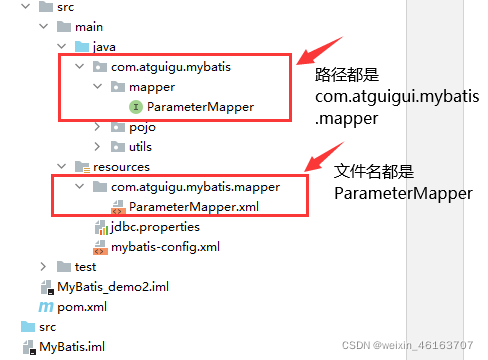
4.创建mapper接口
MyBatis中的mapper接口相当于以前的dao。但是区别在于,mapper仅仅是接口,我们不需要提供实现类
为什么要创建这个接口,因为myBatis有面向接口编程的功能,每当我们去调用接口中的方法,他就是自动匹配一个SQL语句并执行
package com.atguigu.mybatis.mapper;
public interface UserMapper {
/**
* 添加用户信息
*/
int insertUser();
}
5.创建MyBatis的映射文件
- 相关概念:ORM(Object Relationship Mapping)对象关系映射。
- 对象:Java的实体类对象
- 关系:关系型数据库
- 映射:二者之间的对应关系
| Java概念 | 数据库概念 |
| 类 | 表 |
| 属性 | 字段/列 |
| 对象 | 记录/行 |
- 映射文件的命名规则
- 表所对应的实体类的类名+Mapper.xml
- 例如:表t_user,映射的实体类为User,所对应的映射文件为UserMapper.xml
- 因此一个映射文件对应一个实体类,对应一张表的操作
- MyBatis映射文件用于编写SQL,访问以及操作表中的数据
- MyBatis映射文件存放的位置是src/main/resources/mappers目录下
- MyBatis中可以面向接口操作数据,要保证两个一致
- mapper接口的全类名和映射文件的命名空间(namespace)保持一致
- mapper接口中方法的方法名和映射文件中编写SQL的标签的id属性保持一致
- 一个mapper接口对应一个mapper.xml
- 对应一个表
- 对应一个实体类对象
- 对应一个表
<?xml version="1.0" encoding="UTF-8" ?>
<!DOCTYPE mapper
PUBLIC "-//mybatis.org//DTD Mapper 3.0//EN"
"http://mybatis.org/dtd/mybatis-3-mapper.dtd">
<mapper namespace="com.atguigu.mybatis.mapper.UserMapper">
<!--int insertUser();-->
<insert id="insertUser">
insert into t_user values(null,'张三','123',23,'女')
</insert>
</mapper>
*如果表中有自增列,使用insert语句时,不自动提交事务,也会占用。如:表中自增列到了10,提交两次insert,但没有自动提交事务,第三次提交事务后,自增列到13
- 注意:
- 查询的标签select必须设置属性resultType或resultMap,用于设置实体类和数据库表的映射关系
- resultType:自动映射,用于属性名和表中字段名一致的情况
- resultMap:自定义映射,用于一对多或多对一或字段名和属性名不一致的情况
- 当查询的数据为多条时,不能使用实体类作为返回值,只能使用集合,否则会抛出异常TooManyResultsException;但是若查询的数据只有一条,可以使用实体类或集合作为返回值
- 查询的标签select必须设置属性resultType或resultMap,用于设置实体类和数据库表的映射关系
MyBatis获取参数值的两种方式(重点)
- MyBatis获取参数值的两种方式:${}和#{}
- ${}的本质就是字符串拼接,#{}的本质就是占位符赋值
- ${}使用字符串拼接的方式拼接sql,若为字符串类型或日期类型的字段进行赋值时,需要手动加单引号(select from t_user where usrname='admin' 拼接就是
"select from t_user where usrname='"+"admin"+"'"
) - 但是#{}使用占位符赋值的方式拼接sql,此时为字符串类型或日期类型的字段进行赋值时,可以自动添加单引号
单个字面量类型的参数
- 若mapper接口中的方法参数为单个的字面量类型,此时可以使用${}和#{}以任意的名称(最好见名识意)获取参数的值,注意${}需要手动加单引号
<!--User getUserByUsername(String username);-->
<select id="getUserByUsername" resultType="User">
select * from t_user where username = #{username}
</select>
<!--User getUserByUsername(String username);-->
<select id="getUserByUsername" resultType="User">
select * from t_user where username = '${username}'
</select>
多个字面量类型的参数
- 若mapper接口中的方法参数为多个时,此时MyBatis会自动将这些参数放在一个map集合中
- 以arg0,arg1…为键,以参数为值;
- 以param1,param2…为键,以参数为值;
- 因此只需要通过${}和#{}访问map集合的键就可以获取相对应的值,注意${}需要手动加单引号。
- 使用arg或者param都行,要注意的是,arg是从arg0开始的,param是从param1开始的
<!--User checkLogin(String username,String password);-->
<select id="checkLogin" resultType="User">
select * from t_user where username = #{arg0} and password = #{arg1}
</select>
<!--User checkLogin(String username,String password);-->
<select id="checkLogin" resultType="User">
select * from t_user where username = '${param1}' and password = '${param2}'
</select>
使用@Param
public interface UserMapper {
User checkLoginByParam(@Param("username") String username,@Param("password") String password);
}
<!--User CheckLoginByParam(@Param("username") String username, @Param("password") String password);-->
<select id="CheckLoginByParam" resultType="User">
select * from t_user where username = #{username} and password = #{password}
</select>
map集合类型的参数
- 若mapper接口中的方法需要的参数为多个时,此时可以手动创建map集合,将这些数据放在map中只需要通过${}和#{}访问map集合的键就可以获取相对应的值,注意${}需要手动加单引号
<!--User checkLoginByMap(Map<String,Object> map);-->
<select id="checkLoginByMap" resultType="User">
select * from t_user where username = #{username} and password = #{password}
</select>
@Test
public void checkLoginByMap() {
SqlSession sqlSession = SqlSessionUtils.getSqlSession();
ParameterMapper mapper = sqlSession.getMapper(ParameterMapper.class);
Map<String,Object> map = new HashMap<>();
map.put("usermane","admin");
map.put("password","123456");
User user = mapper.checkLoginByMap(map);
System.out.println(user);
}
实体类类型的参数
- 若mapper接口中的方法参数为实体类对象时此时可以使用${}和#{},通过访问实体类对象中的属性名获取属性值,注意${}需要手动加单引号
<!--int insertUser(User user);-->
<insert id="insertUser">
insert into t_user values(null,#{username},#{password},#{age},#{sex},#{email})
</insert>
@Test
public void insertUser() {
SqlSession sqlSession = SqlSessionUtils.getSqlSession();
ParameterMapper mapper = sqlSession.getMapper(ParameterMapper.class);
User user = new User(null,"Tom","123456",12,"男","123@321.com");
mapper.insertUser(user);
}
使用@Param标识参数
- 可以通过@Param注解标识mapper接口中的方法参数,此时,会将这些参数放在map集合中
- 以@Param注解的value属性值为键,以参数为值;
- 以param1,param2…为键,以参数为值;
- 只需要通过${}和#{}访问map集合的键就可以获取相对应的值,注意${}需要手动加单引号
- 只使用在单个字面量类型的参数和多个字面量类型的参数
源码分析
1.首先获取SQL语句的类型,找到SELECT
public MapperMethod(Class<?> mapperInterface, Method method, Configuration config) {
this.command = new MapperMethod.SqlCommand(config, mapperInterface, method);
this.method = new MapperMethod.MethodSignature(config, mapperInterface, method);
}
public Object execute(SqlSession sqlSession, Object[] args) {
Object result;
Object param;
switch(this.command.getType()) {
case INSERT:
param = this.method.convertArgsToSqlCommandParam(args);
result = this.rowCountResult(sqlSession.insert(this.command.getName(), param));
break;
case UPDATE:
param = this.method.convertArgsToSqlCommandParam(args);
result = this.rowCountResult(sqlSession.update(this.command.getName(), param));
break;
case DELETE:
param = this.method.convertArgsToSqlCommandParam(args);
result = this.rowCountResult(sqlSession.delete(this.command.getName(), param));
break;
case SELECT:
if (this.method.returnsVoid() && this.method.hasResultHandler()) {
this.executeWithResultHandler(sqlSession, args);
result = null;
} else if (this.method.returnsMany()) {
result = this.executeForMany(sqlSession, args);
} else if (this.method.returnsMap()) {
result = this.executeForMap(sqlSession, args);
} else if (this.method.returnsCursor()) {
result = this.executeForCursor(sqlSession, args);
} else {
//例子是返回User类型,所以执行这里
param = this.method.convertArgsToSqlCommandParam(args);
result = sqlSession.selectOne(this.command.getName(), param);
if (this.method.returnsOptional() && (result == null || !this.method.getReturnType().equals(result.getClass()))) {
result = Optional.ofNullable(result);
}
}
break;
case FLUSH:
result = sqlSession.flushStatements();
break;
default:
throw new BindingException("Unknown execution method for: " + this.command.getName());
}
if (result == null && this.method.getReturnType().isPrimitive() && !this.method.returnsVoid()) {
throw new BindingException("Mapper method '" + this.command.getName() + " attempted to return null from a method with a primitive return type (" + this.method.getReturnType() + ").");
} else {
return result;
}
}//例子是返回User类型,所以执行这里
param = this.method.convertArgsToSqlCommandParam(args);public Object convertArgsToSqlCommandParam(Object[] args) {
return this.paramNameResolver.getNamedParams(args);
}2.进入最主要的部分
public Object getNamedParams(Object[] args) {
int paramCount = this.names.size();
if (args != null && paramCount != 0) {
if (!this.hasParamAnnotation && paramCount == 1) {
Object value = args[(Integer)this.names.firstKey()];
return wrapToMapIfCollection(value, this.useActualParamName ? (String)this.names.get(0) : null);
} else {
Map<String, Object> param = new ParamMap();
int i = 0;
for(Iterator var5 = this.names.entrySet().iterator(); var5.hasNext(); ++i) {
Entry<Integer, String> entry = (Entry)var5.next();
//entry.getValue()就是获取name的value值,以次为键
//args[(Integer)entry.getKey()]是获得@Param对应的形参值,以此为值
param.put(entry.getValue(), args[(Integer)entry.getKey()]);
String genericParamName = "param" + (i + 1);
if (!this.names.containsValue(genericParamName)) {
//genericParamName是param1.param2....以次为键
//args[(Integer)entry.getKey()]是获得@Param对应的形参值,以此为值
param.put(genericParamName, args[(Integer)entry.getKey()]);
}
}
return param;
}
} else {
return null;
}
}//name是什么呢
int paramCount = this.names.size();3.看name
//那么就是获取所有@Param注解中value值,并且放在map集合中
public ParamNameResolver(Configuration config, Method method) {
this.useActualParamName = config.isUseActualParamName();
Class<?>[] paramTypes = method.getParameterTypes();
//获取所有注解 第一列是注解名,后面每一列都是注解括号里的各种键值对
Annotation[][] paramAnnotations = method.getParameterAnnotations();
SortedMap<Integer, String> map = new TreeMap();
int paramCount = paramAnnotations.length;
for(int paramIndex = 0; paramIndex < paramCount; ++paramIndex) {
if (!isSpecialParameter(paramTypes[paramIndex])) {
String name = null;
Annotation[] var9 = paramAnnotations[paramIndex];
int var10 = var9.length;
for(int var11 = 0; var11 < var10; ++var11) {
Annotation annotation = var9[var11];
if (annotation instanceof Param) {
this.hasParamAnnotation = true;
name = ((Param)annotation).value();
break;
}
}
if (name == null) {
if (this.useActualParamName) {
name = this.getActualParamName(method, paramIndex);
}
if (name == null) {
name = String.valueOf(map.size());
}
}
map.put(paramIndex, name);
}
}
this.names = Collections.unmodifiableSortedMap(map);
}总结
- 建议分成两种情况进行处理
- 实体类类型的参数
- 使用@Param标识参数
MyBatis的各种查询功能
- 如果查询出的数据只有一条,可以通过
- 实体类对象接收 resultType="user"
- List集合接收 resultType="user"
- Map集合接收,结果
{password=123456, sex=男, id=1, age=23, username=admin}resultType="map"
- 如果查询出的数据有多条,一定不能用实体类对象接收,会抛异常TooManyResultsException,可以通过
- 实体类类型的LIst集合接收 resultType="user"
- Map类型的LIst集合接收 resultType="user"
- 在mapper接口的方法上添加@MapKey注解 resultType="map"
查询一个实体类对象
/**
* 根据用户id查询用户信息
* @param id
* @return
*/
User getUserById(@Param("id") int id);
<!--User getUserById(@Param("id") int id);-->
<select id="getUserById" resultType="User">
select * from t_user where id = #{id}
</select>
查询一个List集合
/**
* 查询所有用户信息
* @return
*/
List<User> getUserList();
<!--List<User> getUserList();-->
<select id="getUserList" resultType="User">
select * from t_user
</select>
查询单个数据
resultType 返回值类型
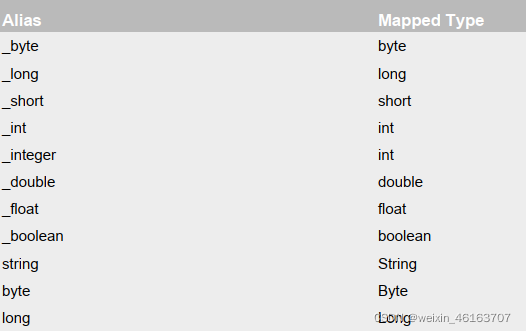

/**
* 查询用户的总记录数
* @return
* 在MyBatis中,对于Java中常用的类型都设置了类型别名
* 例如:java.lang.Integer-->int|integer
* 例如:int-->_int|_integer
* 例如:Map-->map,List-->list
*/
int getCount();
<!--int getCount();-->
<select id="getCount" resultType="_integer">
select count(id) from t_user
</select>
查询一条数据为map集合
/**
* 根据用户id查询用户信息为map集合
* @param id
* @return
*/
Map<String, Object> getUserToMap(@Param("id") int id);
<!--Map<String, Object> getUserToMap(@Param("id") int id);-->
<select id="getUserToMap" resultType="map">
select * from t_user where id = #{id}
</select>
<!--结果:{password=123456, sex=男, id=1, age=23, username=admin}-->
查询多条数据为map集合
方法一
/**
* 查询所有用户信息为map集合
* @return
* 将表中的数据以map集合的方式查询,一条数据对应一个map;若有多条数据,就会产生多个map集合,此时可以将这些map放在一个list集合中获取
*/
List<Map<String, Object>> getAllUserToMap();
<!--Map<String, Object> getAllUserToMap();-->
<select id="getAllUserToMap" resultType="map">
select * from t_user
</select>
<!--
结果:
[{password=123456, sex=男, id=1, age=23, username=admin},
{password=123456, sex=男, id=2, age=23, username=张三},
{password=123456, sex=男, id=3, age=23, username=张三}]
-->
方法二
/**
* 查询所有用户信息为map集合
* @return
* 将表中的数据以map集合的方式查询,一条数据对应一个map;若有多条数据,就会产生多个map集合,并且最终要以一个map的方式返回数据,此时需要通过@MapKey注解设置map集合的键,值是每条数据所对应的map集合
*/
@MapKey("id")
Map<String, Object> getAllUserToMap();
<!--Map<String, Object> getAllUserToMap();-->
<select id="getAllUserToMap" resultType="map">
select * from t_user
</select>
<!--
结果:
{
1={password=123456, sex=男, id=1, age=23, username=admin},
2={password=123456, sex=男, id=2, age=23, username=张三},
3={password=123456, sex=男, id=3, age=23, username=张三}
}
-->
特殊SQL的执行
前情提要:
string username = admin
#{} 的本质 是? 占位符 #{usname}=admin
${}的本质是拼接 #{usname}='admin'
模糊查询
/**
* 根据用户名进行模糊查询
* @param username
* @return java.util.List<com.atguigu.mybatis.pojo.User>
* @date 2022/2/26 21:56
*/
List<User> getUserByLike(@Param("username") String username);
<!--List<User> getUserByLike(@Param("username") String username);-->
<select id="getUserByLike" resultType="User">
<!--select * from t_user where username like '%${mohu}%'-->
<!--select * from t_user where username like concat('%',#{mohu},'%')-->
select * from t_user where username like "%"#{mohu}"%"
</select>
- 其中select * from t_user where username like "%"#{mohu}"%"是最常用的
批量删除
- 只能使用${},如果使用#{},则解析后的sql语句为delete from t_user where id in ('1,2,3'),这样是将1,2,3看做是一个整体,只有id为1,2,3的数据会被删除。正确的语句应该是delete from t_user where id in (1,2,3),或者delete from t_user where id in ('1','2','3')
/**
* 根据id批量删除
* @param ids
* @return int
* @date 2022/2/26 22:06
*/
int deleteMore(@Param("ids") String ids);
<delete id="deleteMore">
delete from t_user where id in (${ids})
</delete>
//测试类
@Test
public void deleteMore() {
SqlSession sqlSession = SqlSessionUtils.getSqlSession();
SQLMapper mapper = sqlSession.getMapper(SQLMapper.class);
int result = mapper.deleteMore("1,2,3,8");
System.out.println(result);
}
动态设置表名
- 只能使用${},因为表名不能加单引号
/**
* 查询指定表中的数据
* @param tableName
* @return java.util.List<com.atguigu.mybatis.pojo.User>
* @date 2022/2/27 14:41
*/
List<User> getUserByTable(@Param("tableName") String tableName);
<!--List<User> getUserByTable(@Param("tableName") String tableName);-->
<select id="getUserByTable" resultType="User">
select * from ${tableName}
</select>
添加功能获取自增的主键
- 使用场景
- t_clazz(clazz_id,clazz_name)
- t_student(student_id,student_name,clazz_id)
- 添加班级信息
- 获取新添加的班级的id
- 为班级分配学生,即将某学的班级id修改为新添加的班级的id
- 在mapper.xml中设置两个属性
- useGeneratedKeys:设置使用自增的主键
- keyProperty:因为增删改有统一的返回值是受影响的行数,因此只能将获取的自增的主键放在传输的参数user对象的某个属性中
/**
* 添加用户信息
* @param user
* @date 2022/2/27 15:04
*/
void insertUser(User user);
<!--void insertUser(User user);-->
<insert id="insertUser" useGeneratedKeys="true" keyProperty="id">
insert into t_user values (null,#{username},#{password},#{age},#{sex},#{email})
</insert>
//测试类
@Test
public void insertUser() {
SqlSession sqlSession = SqlSessionUtils.getSqlSession();
SQLMapper mapper = sqlSession.getMapper(SQLMapper.class);
User user = new User(null, "ton", "123", 23, "男", "123@321.com");
mapper.insertUser(user);
System.out.println(user);
//输出:user{id=10, username='ton', password='123', age=23, sex='男', email='123@321.com'},自增主键存放到了user的id属性中
}
意思就是,如果写成
<!--void insertUser(User user);-->
<insert id="insertUser">
insert into t_user values (null,#{username},#{password},#{age},#{sex},#{email})
</insert>
测试类就是这样
//测试类
@Test
public void insertUser() {
SqlSession sqlSession = SqlSessionUtils.getSqlSession();
SQLMapper mapper = sqlSession.getMapper(SQLMapper.class);
User user = new User(null, "ton", "123", 23, "男", "123@321.com");
mapper.insertUser(user);
System.out.println(user);
//输出:user{id=null, username='ton', password='123', age=23, sex='男', email='123@321.com'},自增主键存放到了user的id属性中
}自定义映射resultMap
resultMap处理字段和属性的映射关系
- resultMap:设置自定义映射
- 属性:
- id:表示自定义映射的唯一标识,不能重复
- type:查询的数据要映射的实体类的类型
- 子标签:
- id:设置主键的映射关系
- result:设置普通字段的映射关系
- 子标签属性:
- property:设置映射关系中实体类中的属性名
- column:设置映射关系中表中的字段名
- 属性:
- 若字段名和实体类中的属性名不一致,则可以通过resultMap设置自定义映射,即使字段名和属性名一致的属性也要映射,也就是全部属性都要列出来
-
<resultMap id="empResultMap" type="Emp"> <id property="eid" column="eid"></id> <result property="empName" column="emp_name"></result> <result property="age" column="age"></result> <result property="sex" column="sex"></result> <result property="email" column="email"></result> </resultMap> <!--List<Emp> getAllEmp();--> <select id="getAllEmp" resultMap="empResultMap"> select * from t_emp </select> -
若字段名和实体类中的属性名不一致,但是字段名符合数据库的规则(使用_),实体类中的属性名符合Java的规则(使用驼峰)。此时也可通过以下两种方式处理字段名和实体类中的属性的映射关系
-
a>可以通过为字段起别名的方式,保证和实体类中的属性名保持一致
-
b>可以在MyBatis的核心配置文件中设置一个全局配置信息mapUnderscoreToCamelCase,可 以在查询表中数据时,自动将_类型的字段名转换为驼峰(详细见上面的配置文件)。例如:字段名user_name,设置了mapUnderscoreToCamelCase,此时字段名就会转换为 userName
-
多对一映射处理
方式一:级联方式处理映射关系
<mapper namespace="com.atguigu.mybatis.mapper.EmpMapper">
<resultMap id="empAndEmpResultMapOne" type="Emp">
<id property="empId" column="emp_id"></id>
<result property="empName" column="emp_name"></result>
<result property="age" column="age"></result>
<result property="sex" column="sex"></result>
<result property="empName" column="emp_name"></result>
<result property="dept.deptId" column="dept_id"></result>
<result property="dept.deptName" column="dept_name"></result>
</resultMap>
<!--Emp getEmpAndDept();-->
<select id="getEmpAndDept" resultMap="empAndEmpResultMapOne">
SELECT * FROM t_dept JOIN t_emp ON t_dept.`dept_id`=t_emp.`dept_id`WHERE t_emp.emp_id=#{empId}
</select>
</mapper>方式二:使用association处理映射关系
- association:处理多对一的映射关系
- property:需要处理多对的映射关系的属性名
- javaType:该属性的类型
<resultMap id="empAndDeptResultMapTwo" type="Emp">
<id property="eid" column="eid"></id>
<result property="empName" column="emp_name"></result>
<result property="age" column="age"></result>
<result property="sex" column="sex"></result>
<result property="email" column="email"></result>
<association property="dept" javaType="Dept">
<id property="did" column="did"></id>
<result property="deptName" column="dept_name"></result>
</association>
</resultMap>
<!--Emp getEmpAndDept(@Param("eid")Integer eid);-->
<select id="getEmpAndDept" resultMap="empAndDeptResultMapTwo">
select * from t_emp left join t_dept on t_emp.eid = t_dept.did where t_emp.eid = #{eid}
</select>
方式三:分步查询
员工表,部门表,根据id查询一个用户的信息和所在的部门信息
第一步-在EmpMapper中
//EmpMapper里的方法
/**
* 通过分步查询,员工及所对应的部门信息
* 分步查询第一步:查询员工信息
* @param
* @return com.atguigu.mybatis.pojo.Emp
* @date 2022/2/27 20:17
*/
Emp getEmpAndDeptByStep(@Param("empId") Integer empId);第二步-在DeptMapper中-已在核心配置文件中配置了属性与字段名自动匹配
//根据部门id查询部门信息
Dept getEmpAndDeptByStepTwo(@Param("deptId")Integer deptId); <!--Dept getEmpAndDeptByStepTwo(@Param("deptId")Integer deptId);-->
<select id="getEmpAndDeptByStepTwo" resultType="dept">
select * from t_dept where dept_id=#{deptId}
</select>第三步整合前两步-在EmpMapper(主表对应的Mapper)中
association中的参数说明:
- association:处理多对一的映射关系
- property:需要处理多对的映射关系的属性名
- column:两表相连的条件的字段名对应的属性名,例:
SELECT * FROM t_dept JOIN t_emp ON t_dept.`dept_id`=t_emp.`dept_id`WHERE t_emp.emp_id=1 中的t_dept.`dept_id`=t_emp.`dept_id`中的`dept_id`
- select:设置分布查询的sql的唯一标识(namespace.SQLId或mapper接口的全类名.方法名),即我第二步应该执行哪个查询语句
<resultMap id="empAndEmpResultMapStep" type="Emp">
<id property="empId" column="emp_id"></id>
<result property="empName" column="emp_name"></result>
<result property="age" column="age"></result>
<result property="sex" column="sex"></result>
<association property="dept"
column="dept_id"
select="com.atguigu.mybatis.mapper.DeptMapper.getEmpAndDeptByStepTwo">
</association>
</resultMap>
<!--Emp getEmpAndDeptByStep(@Param("empId") Integer empId);-->
<select id="getEmpAndDeptByStep" resultMap="empAndEmpResultMapStep">
select * from t_emp where emp_id=#{empId}
</select>输出结果:

一对多映射处理
public class Dept {
private Integer deptId;
private String deptName;
private List<Emp> emps;
......方式一:使用collection处理映射关系
- collection:用来处理一对多的映射关系
- ofType:表示该属性对应的集合中存储的数据的类型(多对一中javaType是指属性的类型,一对多collection是指集合中存储的数据的类型)
<resultMap id="DeptAndEmpResultMap" type="Dept">
<id property="did" column="did"></id>
<result property="deptName" column="dept_name"></result>
<collection property="emps" ofType="Emp">
<id property="eid" column="eid"></id>
<result property="empName" column="emp_name"></result>
<result property="age" column="age"></result>
<result property="sex" column="sex"></result>
<result property="email" column="email"></result>
</collection>
</resultMap>
<!--Dept getDeptAndEmp(@Param("did") Integer did);-->
<select id="getDeptAndEmp" resultMap="DeptAndEmpResultMap">
select * from t_dept left join t_emp on t_dept.did = t_emp.did where t_dept.did = #{did}
</select>方法二:分步查询
第一步:根据部门id查询部门信息
Dept getDeptAndEmpByStepOne(@Param("deptId")Integer deptId);第二步:根据部门id查询用户信息-已在核心配置文件中配置了属性与字段名自动匹配
List<Emp> getDeptAndEmpByStepTwo(@Param("deptId") Integer deptId); <!--Emp getDeptAndEmpByStepTwo(@Param("empId") Integer empId);-->
<select id="getDeptAndEmpByStepTwo" resultType="emp">
select * from t_emp where dept_id=#{deptId}
</select>第三步:整合前两步
<resultMap id="deptAndEmpResultMap" type="Dept">
<id property="deptId" column="dept_id"></id>
<result property="deptName" column="dept_name"></result>
<collection property="emps"
column="dept_id"
select="com.atguigu.mybatis.mapper.EmpMapper.getDeptAndEmpByStepTwo">
</collection>
</resultMap>
<!--Dept getDeptAndEmpByStepOne(@Param("deptId")Integer deptId);-->
<select id="getDeptAndEmpByStepOne" resultMap="deptAndEmpResultMap">
select * from t_dept where dept_id=#{deptId}
</select>输出结果:

总结:
多对一:
1.association:
①<association property="dept" javaType="Dept"> javaType中填写的是多对一中的“一”的属性类型
②association和collection中不会再写外键的内容了,不然会无限套娃
2.分布查询
①resultMap中使用association
②分步查询时候,只需要第一步设置resultMap,如果第二步没有分步查询则不需要,直接resultType,前提是字段名可以跟属性对应
好处:(多个查询分开,各自就有自己的功能,合并起来还能多表查询)可以实现延迟加载
一对多:
collection(一对多,collection中写的是多,多的肯定由集合组成):
①<collection property="emps" ofType="Emp"> ofType中写的是一对多,“多”对应的列表中的数据类型
②association和collection中不会再写外键的内容了,不然会无限套娃
2.分布查询
①resultMap中使用association
②分步查询时候,只需要第一步设置resultMap,如果第二步没有分步查询则不需要,直接resultType,前提是字段名可以跟属性对应
延迟加载
- 分步查询的优点:可以实现延迟加载,但是必须在核心配置文件中设置全局配置信息(详见上面的核心配置文件):
- lazyLoadingEnabled:延迟加载的全局开关。当开启时,所有关联对象都会延迟加载。默认是false
- aggressiveLazyLoading:当开启时,任何方法的调用都会加载该对象的所有属性,此时按需加载就失效了。 否则,每个属性会按需加载。默认是false
<resultMap id="empAndDeptByStepResultMap" type="Emp">
<id property="eid" column="eid"></id>
<result property="empName" column="emp_name"></result>
<result property="age" column="age"></result>
<result property="sex" column="sex"></result>
<result property="email" column="email"></result>
<association property="dept"
select="com.atguigu.mybatis.mapper.DeptMapper.getEmpAndDeptByStepTwo"
column="did"
fetchType="lazy"></association>
</resultMap>
- 此时就可以实现按需加载,获取的数据是什么,就只会执行相应的sql。此时可通过association和collection中的fetchType属性设置当前的分步查询是否使用延迟加载(如上),fetchType=“lazy(延迟加载)|eager(立即加载)”
<settings>
<!--开启延迟加载-->
<setting name="lazyLoadingEnabled" value="true"/>
</settings>
例子中部门dept有属性List<Emp> emps 存在一对多的关系,且getDeptAndEmpByStepOne()是一对多的分步查询
此时只想获取对应部门的deptName,此时因为延迟加载,只会执行分步查询的第一步
@Test
public void getDeptAndEmpByStep(){
SqlSession sqlSession = SqlSessionUtils.getSqlSession();
DeptMapper deptMapper = sqlSession.getMapper(DeptMapper.class);
Dept dept= deptMapper.getDeptAndEmpByStepOne(1);
System.out.println(dept.getDeptName());
}
此时想得到1号部门所有的员工,就需要分步查询
@Test
public void getDeptAndEmpByStep(){
SqlSession sqlSession = SqlSessionUtils.getSqlSession();
DeptMapper deptMapper = sqlSession.getMapper(DeptMapper.class);
Dept dept= deptMapper.getDeptAndEmpByStepOne(1);
System.out.println(dept.getDeptName());
System.out.println(dept.getEmps());
} 
动态SQL
if
- if标签可通过test属性(即传递过来的数据)的表达式进行判断,若表达式的结果为true,则标签中的内容会执行;反之标签中的内容不会执行
- 在where后面添加一个恒成立条件1=1
- 这个恒成立条件并不会影响查询的结果
- 这个1=1可以用来拼接and语句,例如:当empName为null时
- 如果不加上恒成立条件,则SQL语句为select * from t_emp where and age = ? and sex = ? and email = ?,此时where会与and连用,SQL语句会报错
- 如果加上一个恒成立条件,则SQL语句为select * from t_emp where 1= 1 and age = ? and sex = ? and email = ?,此时不报错
<!--List<Emp> getEmpByCondition(Emp emp);-->
<select id="getEmpByCondition" resultType="Emp">
select * from t_emp where 1=1
<if test="empName != null and empName !=''">
and emp_name = #{empName}
</if>
<if test="age != null and age !=''">
and age = #{age}
</if>
<if test="sex != null and sex !=''">
and sex = #{sex}
</if>
<if test="email != null and email !=''">
and email = #{email}
</if>
</select>
where
- where和if一般结合使用:
- 若where标签中的if条件都不满足,则where标签没有任何功能,即不会添加where关键字
- 若where标签中的if条件满足,则where标签会自动添加where关键字,并将条件最前方多余的and/or去掉
<!--List<Emp> getEmpByCondition(Emp emp);-->
<select id="getEmpByCondition" resultType="Emp">
select * from t_emp
<where>
<if test="empName != null and empName !=''">
emp_name = #{empName}
</if>
<if test="age != null and age !=''">
and age = #{age}
</if>
<if test="sex != null and sex !=''">
and sex = #{sex}
</if>
<if test="email != null and email !=''">
and email = #{email}
</if>
</where>
</select>
注意:where标签不能去掉条件后多余的and/or
@Test
public void testDynamicSQLIf(){
SqlSession sqlSession = SqlSessionUtils.getSqlSession();
EmpMapper empMapper = sqlSession.getMapper(EmpMapper.class);
Emp emp = empMapper.getDeptByDynamicSQL(new Emp(null, "", 29, "男"));
} <!--Emp getDeptByDynamicSQL(Emp emp);-->
<select id="getDeptByDynamicSQL" resultType="emp">
select * from t_emp
<where>
<if test="empName != null and empName !=''">
and emp_name=#{empName}
</if>
<if test="age !=null and age !=''">
and age=#{age}
</if>
<if test="sex!=null and sex!=''">
sex=#{sex} and
</if>
</where>
</select> 
trim
- rim用于去掉或添加标签中的内容
- 常用属性
- prefix:在trim标签中的内容的前面添加某些内容
- suffix:在trim标签中的内容的后面添加某些内容
- prefixOverrides:在trim标签中的内容的前面去掉某些内容
- suffixOverrides:在trim标签中的内容的后面去掉某些内容
- 若trim中的标签都不满足条件,则trim标签没有任何效果,也就是只剩下select * from t_emp
<!--List<Emp> getEmpByCondition(Emp emp);-->
<select id="getEmpByCondition" resultType="Emp">
select * from t_emp
<trim prefix="where" suffixOverrides="and|or">
<if test="empName != null and empName !=''">
emp_name = #{empName} and
</if>
<if test="age != null and age !=''">
age = #{age} and
</if>
<if test="sex != null and sex !=''">
sex = #{sex} or
</if>
<if test="email != null and email !=''">
email = #{email}
</if>
</trim>
</select>
//测试类
@Test
public void getEmpByCondition() {
SqlSession sqlSession = SqlSessionUtils.getSqlSession();
DynamicSQLMapper mapper = sqlSession.getMapper(DynamicSQLMapper.class);
List<Emp> emps= mapper.getEmpByCondition(new Emp(null, "张三", null, null, null, null));
System.out.println(emps);
}

choose、when、otherwise
choose、when、otherwise相当于if...else if..else- when至少要有一个,otherwise至多只有一个
<select id="getEmpByChoose" resultType="Emp">
select * from t_emp
<where>
<choose>
<when test="empName != null and empName != ''">
emp_name = #{empName}
</when>
<when test="age != null and age != ''">
age = #{age}
</when>
<when test="sex != null and sex != ''">
sex = #{sex}
</when>
<when test="email != null and email != ''">
email = #{email}
</when>
<otherwise>
did = 1
</otherwise>
</choose>
</where>
</select>
@Test
public void getEmpByChoose() {
SqlSession sqlSession = SqlSessionUtils.getSqlSession();
DynamicSQLMapper mapper = sqlSession.getMapper(DynamicSQLMapper.class);
List<Emp> emps = mapper.getEmpByChoose(new Emp(null, "张三", 23, "男", "123@qq.com", null));
System.out.println(emps);
}
- 相当于
if a else if b else if c else d,只会执行其中一个
foreach
-
属性:
- collection:设置要循环的数组或集合
- item:表示集合或数组中的每一个数据,并不是类型,而是对象名
- separator:设置循环体之间的分隔符,分隔符前后默认有一个空格,如
, - open:设置foreach标签中的内容的开始符
- close:设置foreach标签中的内容的结束符
-
批量删除(加上@param)
-
<!--int deleteMoreByArray(Integer[] eids);--> <delete id="deleteMoreByArray"> delete from t_emp where eid in <foreach collection="eids" item="eid" separator="," open="(" close=")"> #{eid} </foreach> </delete>@Test public void deleteMoreByArray() { SqlSession sqlSession = SqlSessionUtils.getSqlSession(); DynamicSQLMapper mapper = sqlSession.getMapper(DynamicSQLMapper.class); int result = mapper.deleteMoreByArray(new Integer[]{6, 7, 8, 9}); System.out.println(result); } -
批量添加(加上@param)
-
int insertEmps(@Param("empList") List<Emp> empList); -
<!--int insertMoreByList(@Param("emps") List<Emp> emps);--> <insert id="insertMoreByList"> insert into t_emp values <foreach collection="emps" item="emp" separator=","> (null,#{emp.empName},#{emp.age},#{emp.sex},#{emp.email},null) </foreach> </insert>@Test public void insertMoreByList() { SqlSession sqlSession = SqlSessionUtils.getSqlSession(); DynamicSQLMapper mapper = sqlSession.getMapper(DynamicSQLMapper.class); Emp emp1 = new Emp(null,"a",1,"男","123@321.com",null); Emp emp2 = new Emp(null,"b",1,"男","123@321.com",null); Emp emp3 = new Emp(null,"c",1,"男","123@321.com",null); List<Emp> emps = Arrays.asList(emp1, emp2, emp3); int result = mapper.insertMoreByList(emps); System.out.println(result); }
SQL片段
- sql片段,可以记录一段公共sql片段,在使用的地方通过include标签进行引入
- 声明sql片段:
<sql>标签 -
<sql id="empColumns">eid,emp_name,age,sex,email</sql> - 引用sql片段:
<include>标签 -
<!--List<Emp> getEmpByCondition(Emp emp);--> <select id="getEmpByCondition" resultType="Emp"> select <include refid="empColumns"></include> from t_emp </select>MyBatis的缓存(只针对查询)
MyBatis的一级缓存
- 一级缓存是SqlSession级别的,通过同一个SqlSession查询的数据会被缓存,下次查询相同的数据,就会从缓存中直接获取,不会从数据库重新访问
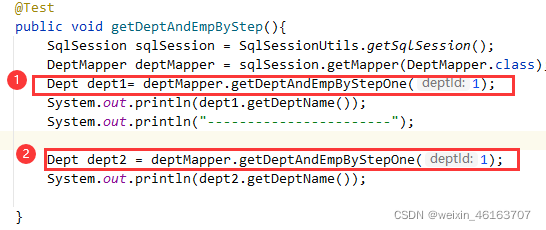

- 使一级缓存失效的四种情况:
- 不同的SqlSession对应不同的一级缓存
- 同一个SqlSession但是查询条件不同
- 同一个SqlSession两次查询期间执行了任何一次增删改操作(增删改可能会对查询的数据产生影响)
- 同一个SqlSession两次查询期间手动清空了缓存( sqlSession.clearCache(); )
MyBatis的二级缓存
- 二级缓存是SqlSessionFactory级别,通过同一个SqlSessionFactory创建的SqlSession查询的结果会被缓存;此后若再次执行相同的查询语句,结果就会从缓存中获取
- 二级缓存开启的条件
- 在核心配置文件中,设置全局配置属性cacheEnabled=“true”,默认为true,不需要设置
- 在映射文件(.xml)中设置标签 <cache></cache>
- 二级缓存必须在SqlSession关闭(sqlSession1.close();)或提交(sqlSession1.commit();)之后有效
- 查询的数据所转换的实体类类型必须实现序列化的接口(public class Emp implements Serializable)
- 使二级缓存失效的情况:两次查询之间执行了任意的增删改,会使一级和二级缓存同时失效
二级缓存的相关配置
- 在mapper配置文件中添加的cache标签可以设置一些属性
- eviction属性:缓存回收策略
- LRU(Least Recently Used) – 最近最少使用的:移除最长时间不被使用的对象。
- FIFO(First in First out) – 先进先出:按对象进入缓存的顺序来移除它们。
- SOFT – 软引用:移除基于垃圾回收器状态和软引用规则的对象。
- WEAK – 弱引用:更积极地移除基于垃圾收集器状态和弱引用规则的对象。
- 默认的是 LRU
- flushInterval属性:刷新间隔,单位毫秒
- 默认情况是不设置,也就是没有刷新间隔,缓存仅仅调用语句(增删改)时刷新
- size属性:引用数目,正整数
- 代表缓存最多可以存储多少个对象,太大容易导致内存溢出
- readOnly属性:只读,true/false
- true:只读缓存;会给所有调用者返回缓存对象的相同实例。因此这些对象不能被修改。这提供了很重要的性能优势。
- false:读写缓存;会返回缓存对象的拷贝(通过序列化)。这会慢一些,但是安全,因此默认是false
MyBatis缓存查询的顺序
- 先查询二级缓存,因为二级缓存中可能会有其他程序已经查出来的数据,可以拿来直接使用
- 如果二级缓存没有命中,再查询一级缓存
- 如果一级缓存也没有命中,则查询数据库
- SqlSession关闭之后,一级缓存中的数据会写入二级缓存
整合第三方缓存EHCache(了解)
添加依赖
<!-- Mybatis EHCache整合包 -->
<dependency>
<groupId>org.mybatis.caches</groupId>
<artifactId>mybatis-ehcache</artifactId>
<version>1.2.1</version>
</dependency>
<!-- slf4j日志门面的一个具体实现 -->
<dependency>
<groupId>ch.qos.logback</groupId>
<artifactId>logback-classic</artifactId>
<version>1.2.3</version>
</dependency>

创建EHCache的配置文件ehcache.xml
- 名字必须叫
ehcache.xml
<?xml version="1.0" encoding="utf-8" ?>
<ehcache xmlns:xsi="http://www.w3.org/2001/XMLSchema-instance"
xsi:noNamespaceSchemaLocation="../config/ehcache.xsd">
<!-- 磁盘保存路径 -->
<diskStore path="D:\atguigu\ehcache"/>
<defaultCache
maxElementsInMemory="1000"
maxElementsOnDisk="10000000"
eternal="false"
overflowToDisk="true"
timeToIdleSeconds="120"
timeToLiveSeconds="120"
diskExpiryThreadIntervalSeconds="120"
memoryStoreEvictionPolicy="LRU">
</defaultCache>
</ehcache>
设置二级缓存的类型
- 在xxxMapper.xml文件中设置二级缓存类型
<cache type="org.mybatis.caches.ehcache.EhcacheCache"/>
加入logback日志
- 存在SLF4J时,作为简易日志的log4j将失效,此时我们需要借助SLF4J的具体实现logback来打印日志。创建logback的配置文件
logback.xml,名字固定,不可改变
<?xml version="1.0" encoding="UTF-8"?>
<configuration debug="true">
<!-- 指定日志输出的位置 -->
<appender name="STDOUT"
class="ch.qos.logback.core.ConsoleAppender">
<encoder>
<!-- 日志输出的格式 -->
<!-- 按照顺序分别是:时间、日志级别、线程名称、打印日志的类、日志主体内容、换行 -->
<pattern>[%d{HH:mm:ss.SSS}] [%-5level] [%thread] [%logger] [%msg]%n</pattern>
</encoder>
</appender>
<!-- 设置全局日志级别。日志级别按顺序分别是:DEBUG、INFO、WARN、ERROR -->
<!-- 指定任何一个日志级别都只打印当前级别和后面级别的日志。 -->
<root level="DEBUG">
<!-- 指定打印日志的appender,这里通过“STDOUT”引用了前面配置的appender -->
<appender-ref ref="STDOUT" />
</root>
<!-- 根据特殊需求指定局部日志级别 -->
<logger name="com.atguigu.crowd.mapper" level="DEBUG"/>
</configuration>
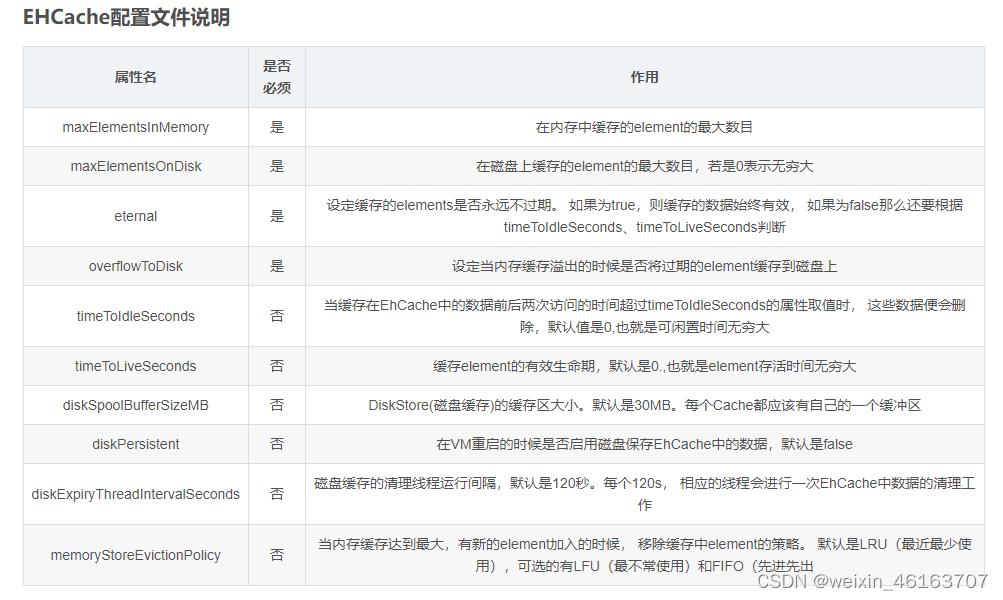
MyBatis的逆向工程
- 正向工程:先创建Java实体类,由框架负责根据实体类生成数据库表。Hibernate是支持正向工程的
- 逆向工程:先创建数据库表,由框架负责根据数据库表,反向生成如下资源:
- Java实体类
- Mapper接口
- Mapper映射文件
创建逆向工程的步骤
添加依赖和插件(pom.xml)
<!-- 控制Maven在构建过程中相关配置 -->
<build>
<!-- 构建过程中用到的插件 -->
<plugins>
<!-- 具体插件,逆向工程的操作是以构建过程中插件形式出现的 -->
<plugin>
<groupId>org.mybatis.generator</groupId>
<artifactId>mybatis-generator-maven-plugin</artifactId>
<version>1.3.0</version>
<!-- 插件的依赖 -->
<dependencies>
<!-- 逆向工程的核心依赖 -->
<dependency>
<groupId>org.mybatis.generator</groupId>
<artifactId>mybatis-generator-core</artifactId>
<version>1.3.2</version>
</dependency>
<!-- 数据库连接池 -->
<dependency>
<groupId>com.mchange</groupId>
<artifactId>c3p0</artifactId>
<version>0.9.2</version>
</dependency>
<!-- MySQL驱动 -->
<dependency>
<groupId>mysql</groupId>
<artifactId>mysql-connector-java</artifactId>
<version>8.0.16</version>
</dependency>
</dependencies>
</plugin>
</plugins>
</build>创建MyBatis的核心配置文件 -mybaits-config.xml
- 文件名必须是:
generatorConfig.xml -
<?xml version="1.0" encoding="UTF-8"?> <!DOCTYPE generatorConfiguration PUBLIC "-//mybatis.org//DTD MyBatis Generator Configuration 1.0//EN" "http://mybatis.org/dtd/mybatis-generator-config_1_0.dtd"> <generatorConfiguration> <!-- targetRuntime: 执行生成的逆向工程的版本 MyBatis3Simple: 生成基本的CRUD(清新简洁版) MyBatis3: 生成带条件的CRUD(奢华尊享版) --> <context id="DB2Tables" targetRuntime="MyBatis3"> <!-- 数据库的连接信息 --> <jdbcConnection driverClass="com.mysql.cj.jdbc.Driver" connectionURL="jdbc:mysql://localhost:3306/mybatis?serverTimezone=GMT%2B8&useUnicode=true&characterEncoding=utf8&autoReconnect=true&useSSL=false&rewriteBatchedStatements=true" userId="root" password="root"> </jdbcConnection> <!-- javaBean的生成策略--> <javaModelGenerator targetPackage="com.atguigu.mybatis.pojo" targetProject=".\src\main\java"> <property name="enableSubPackages" value="true" /> <property name="trimStrings" value="true" /> </javaModelGenerator> <!-- SQL映射文件的生成策略 --> <sqlMapGenerator targetPackage="com.atguigu.mybatis.mapper" targetProject=".\src\main\resources"> <property name="enableSubPackages" value="true" /> </sqlMapGenerator> <!-- Mapper接口的生成策略 --> <javaClientGenerator type="XMLMAPPER" targetPackage="com.atguigu.mybatis.mapper" targetProject=".\src\main\java"> <property name="enableSubPackages" value="true" /> </javaClientGenerator> <!-- 逆向分析的表 --> <!-- tableName设置为*号,可以对应所有表,此时不写domainObjectName --> <!-- domainObjectName属性指定生成出来的实体类的类名 --> <table tableName="t_emp" domainObjectName="Emp"/> <table tableName="t_dept" domainObjectName="Dept"/> </context> </generatorConfiguration>启动:
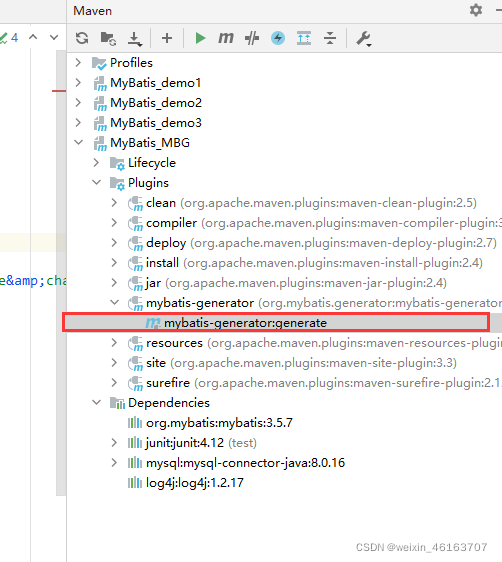
QBC
查询
selectByExample:按条件查询,需要传入一个example对象或者null;如果传入一个null,则表示没有条件,也就是查询所有数据example.createCriteria().xxx:创建条件对象,通过andXXX方法为SQL添加查询添加,每个条件之间是and关系example.or().xxx:将之前添加的条件通过or拼接其他条件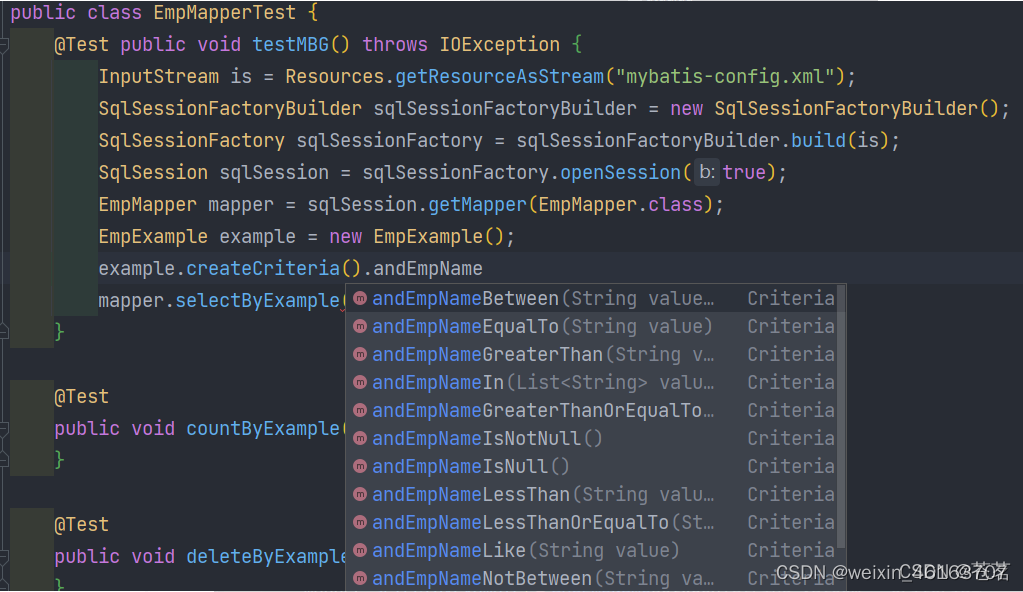
@Test public void testMBG() throws IOException {
InputStream is = Resources.getResourceAsStream("mybatis-config.xml");
SqlSessionFactoryBuilder sqlSessionFactoryBuilder = new SqlSessionFactoryBuilder();
SqlSessionFactory sqlSessionFactory = sqlSessionFactoryBuilder.build(is);
SqlSession sqlSession = sqlSessionFactory.openSession(true);
EmpMapper mapper = sqlSession.getMapper(EmpMapper.class);
EmpExample example = new EmpExample();
//名字为张三,且年龄大于等于20
example.createCriteria().andEmpNameEqualTo("张三").andAgeGreaterThanOrEqualTo(20);
//或者did不为空
example.or().andDidIsNotNull();
List<Emp> emps = mapper.selectByExample(example);
emps.forEach(System.out::println);
}

-
updateByPrimaryKey:通过主键进行数据修改,如果某一个值为null,也会将对应的字段改为nullmapper.updateByPrimaryKey(new Emp(1,"admin",22,null,"456@qq.com",3));
updateByPrimaryKeySelective():通过主键进行选择性数据修改,如果某个值为null,则不修改这个字段mapper.updateByPrimaryKeySelective(new Emp(2,"admin2",22,null,"456@qq.com",3))
分页插件
分页插件使用步骤
添加依赖配置分页插件
<!-- https://mvnrepository.com/artifact/com.github.pagehelper/pagehelper -->
<dependency>
<groupId>com.github.pagehelper</groupId>
<artifactId>pagehelper</artifactId>
<version>5.2.0</version>
</dependency>配置分页插件
- 在MyBatis的核心配置文件(mybatis-config.xml)中配置插件
<plugins>
<!--设置分页插件-->
<plugin interceptor="com.github.pagehelper.PageInterceptor"></plugin>
</plugins>
分页插件的使用
开启分页功能
- 在查询功能之前使用
PageHelper.startPage(int pageNum, int pageSize)开启分页功能- pageNum:当前页的页码
- pageSize:每页显示的条数
@Test
public void testPageHelper() throws IOException {
InputStream is = Resources.getResourceAsStream("mybatis-config.xml");
SqlSessionFactoryBuilder sqlSessionFactoryBuilder = new SqlSessionFactoryBuilder();
SqlSessionFactory sqlSessionFactory = sqlSessionFactoryBuilder.build(is);
SqlSession sqlSession = sqlSessionFactory.openSession(true);
EmpMapper mapper = sqlSession.getMapper(EmpMapper.class);
//访问第一页,每页四条数据
PageHelper.startPage(1,4);
List<Emp> emps = mapper.selectByExample(null);
emps.forEach(System.out::println);
}

分页相关数据
方法一:直接输出
@Test
public void testPageHelper() throws IOException {
InputStream is = Resources.getResourceAsStream("mybatis-config.xml");
SqlSessionFactoryBuilder sqlSessionFactoryBuilder = new SqlSessionFactoryBuilder();
SqlSessionFactory sqlSessionFactory = sqlSessionFactoryBuilder.build(is);
SqlSession sqlSession = sqlSessionFactory.openSession(true);
EmpMapper mapper = sqlSession.getMapper(EmpMapper.class);
//访问第一页,每页四条数据
Page<Object> page = PageHelper.startPage(1, 4);
List<Emp> emps = mapper.selectByExample(null);
//在查询到List集合后,打印分页数据
System.out.println(page);
}
分页相关数据:
Page{count=true, pageNum=1, pageSize=4, startRow=0, endRow=4, total=8, pages=2, reasonable=false, pageSizeZero=false}[Emp{eid=1, empName='admin', age=22, sex='男', email='456@qq.com', did=3}, Emp{eid=2, empName='admin2', age=22, sex='男', email='456@qq.com', did=3}, Emp{eid=3, empName='王五', age=12, sex='女', email='123@qq.com', did=3}, Emp{eid=4, empName='赵六', age=32, sex='男', email='123@qq.com', did=1}]
方法二使用PageInfo
- 在查询获取list集合之后(之前一定要使用
startPage),使用PageInfo<T> pageInfo = new PageInfo<>(List<T> list, intnavigatePages)获取分页相关数据- list:分页之后的数据
- navigatePages:导航分页的页码数(页面显示的页码,比如写5,我们可以在导航栏点击5个数字)
@Test
public void testPageHelper() throws IOException {
InputStream is = Resources.getResourceAsStream("mybatis-config.xml");
SqlSessionFactoryBuilder sqlSessionFactoryBuilder = new SqlSessionFactoryBuilder();
SqlSessionFactory sqlSessionFactory = sqlSessionFactoryBuilder.build(is);
SqlSession sqlSession = sqlSessionFactory.openSession(true);
EmpMapper mapper = sqlSession.getMapper(EmpMapper.class);
PageHelper.startPage(1, 4);
List<Emp> emps = mapper.selectByExample(null);
PageInfo<Emp> page = new PageInfo<>(emps,5);
System.out.println(page);
}
分页相关数据:
PageInfo{
pageNum=1, pageSize=4, size=4, startRow=1, endRow=4, total=8, pages=2,
list=Page{count=true, pageNum=1, pageSize=4, startRow=0, endRow=4, total=8, pages=2, reasonable=false, pageSizeZero=false}[Emp{eid=1, empName='admin', age=22, sex='男', email='456@qq.com', did=3}, Emp{eid=2, empName='admin2', age=22, sex='男', email='456@qq.com', did=3}, Emp{eid=3, empName='王五', age=12, sex='女', email='123@qq.com', did=3}, Emp{eid=4, empName='赵六', age=32, sex='男', email='123@qq.com', did=1}],
prePage=0, nextPage=2, isFirstPage=true, isLastPage=false, hasPreviousPage=false, hasNextPage=true, navigatePages=5, navigateFirstPage=1, navigateLastPage=2, navigatepageNums=[1, 2]}
- 其中list中的数据等同于方法一中直接输出的page数据
-
常用数据:
- pageNum:当前页的页码
- pageSize:每页显示的条数
- size:当前页显示的真实条数
- total:总记录数
- pages:总页数
- prePage:上一页的页码
- nextPage:下一页的页码
- isFirstPage/isLastPage:是否为第一页/最后一页
- hasPreviousPage/hasNextPage:是否存在上一页/下一页
- navigatePages:导航分页的页码数
- navigatepageNums:导航分页的页码,[1,2,3,4,5]